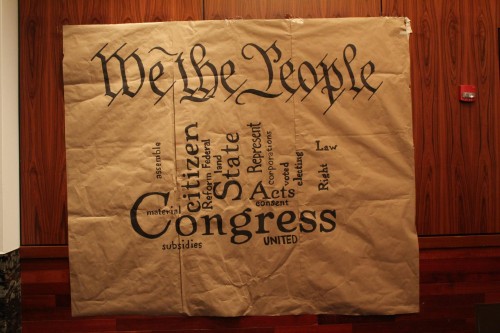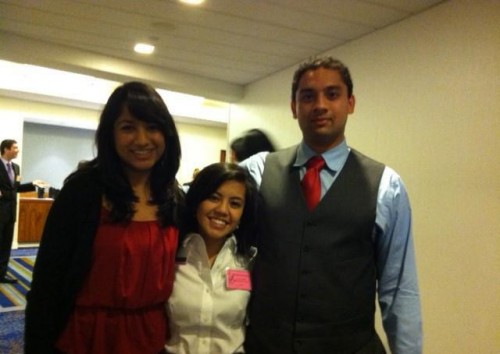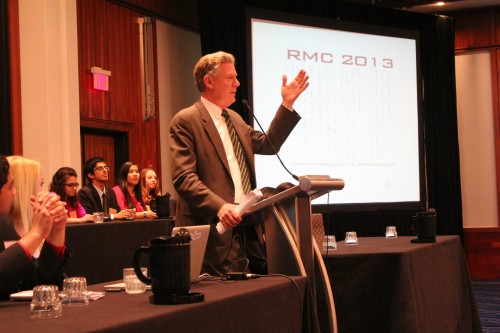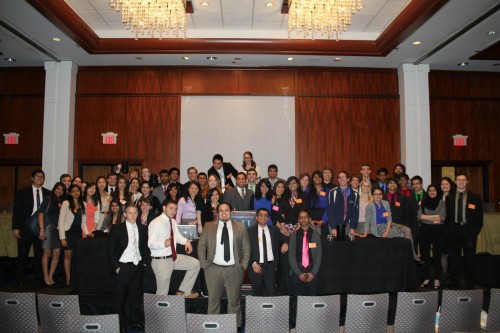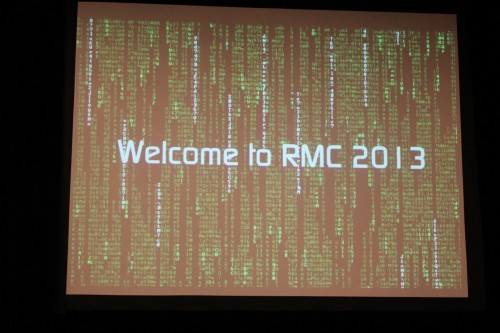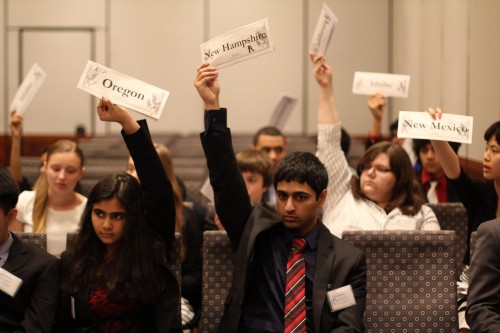This past weekend kicked of Rutgers Model Congress (RMC) 2013, and this was one to remember. The conference brought over 400 high school students to New Brunswick, New Jersey to discuss various issues pertaining to American public policy. All of the events at RMC were tied together with theme of “Constitutionalism in the Information Age.” This theme challenged students to consider the fundamental purpose of government, and think about how the Constitution has to be reimagined and reinterpreted in an era increasingly dominated by technological innovations.
Opening ceremonies started with a bang as the keynote speaker, Congressman Frank Pallone from New Jersey’s 6th congressional district, spoke forcefully about the role of the Internet in today’s politics. He talked about the irony of enhanced communications technology actually decreasing the effectiveness of communication in Congress. In an era where people could easily e-mail or tweet their views, members of Congress have failed to have face-to-face discussions with one another. He also spoke about the importance of education, and inspired students to get involved with politics as he himself started as a high school student participating in Model Congress. The opening ceremonies concluded with a thematic video introducing various topics at the conference, as well as the mysterious hacktivist group, “Anonymous.” Students were intrigued by Anonymous, and it became a critical part of the ongoing crisis implementation throughout the conference. Watch the opening ceremony here.
Every RMC features educational workshops in between the second and third committee sessions on Friday afternoon, and this year we had some great ones to highlight. As per the norm, we featured some skill-based workshops led by staff members, including “Public Speaking” and “Bill Writing.” We were also proud to host two workshops conducted by outside organizations. Trevor Burrus of the Cato Institute, the nation’s premiere libertarian think tank, led a workshop about the libertarian perspective on the Constitution. As I walked in at the end of the workshop (having just finished up by own about the history of technology and democracy), I saw a student going up to Mr. Burrus and telling him, “You’re like a wizard! I learned so much, thank you!!” Those words were music to my ears as these workshops were intended to help the students learn something beyond committee and by all means this one succeeded.
The other workshop that I would like to highlight was one on U.S. Foreign Policy and Media that was conducted by the Center for Constitutional Rights (CCR). The CCR is a non-profit litigation firm dedicated to fighting for civil liberties, and most famously it is currently litigating cases about drone strikes and detainees in Guantanamo Bay. A panel of experts presented an excellent overview of U.S. foreign policy in the Israel-Palestine conflict, and explored new territory by connecting policy to technology and showing students how the two are interlinked even when the connection does not seem obvious. At the end of the workshop, multiple students were asking about how they could get involved with the CCR and its mission. This made me extremely happy because one of our goals at IDIA is to help students take what they learn from Model UN and Model Congress conferences and go make a difference in their communities; I am sure that after that workshop many of these students will become activists for these causes.
In committee, the students had an unparalleled experience. The conference featured eighteen substantive committees. The House of Representatives, Senate, and Advanced committees each had six represented, and each one featured its own unique topics and procedures. All of the topics tied into the overall theme of “Constitutionalism in the Information Age” and the students explored several key ideas that emerged in the context of the theme. Some students explored topics relating to consumer protection in the Information Age including “the Digital Economy” in Senate Commerce, Science and Transportation, “Consumer Credit Data” in House Financial Services, “Genetically Modified Organisms” in Senate Agriculture, Nutrition, and Forestry, “Assisted Reproductive Technology” in House Science, Space, and Technology, and “Re-evaluating Federal Education Programs” in Senate Health, Education, Labor, and Pensions. Others dealt with national security problems such as the “National Defense Authorization Act” in House Armed Services, “Disaster Preparedness” in Senate Homeland Security and Governmental Affairs, and “Information Assurance and Signals Intelligence” in the National Security Agency. Still others answered questions about the nature of privacy and other constitutional rights in a digital era through topics such as “Copyright Law and Online Piracy” in Senate Judiciary, “Cloud Computing” in House Judiciary, and net neutrality in the President’s Technology Roundtable. Each topic and committee was cutting edge and encompassed some aspect of the conference theme, making sure that every student left with an idea about the role of government in the face of a technological revolution.
Beyond just the topics, the staff at RMC 2013 ensured that the educational experience was top notch. The Directors, who enroll in a class during the Fall semester, each produced two 25-page policy briefs to help the students prepare for the conference. At the conference itself, the staff was trained to interact with students and act as teachers rather than as moderators. I received endless praise from both advisors and students saying that the Directors engaged the students in a way rarely seen at conference. Directors frequently took time out of debate to stop and answer any questions the students may have had. They were active in editing bills and giving students feedback throughout their unmoderated caucuses to ensure that every bill was realistic and that the students were as specific as possible.
Crisis elements at this RMC went far beyond the norm. The crisis staffers introduced two parallel storylines that ran throughout several committees at the conference. One storyline focused on a national security crisis revolving around drone technology. The National Security Agency (NSA) and Senate Foreign Relations committee investigated the theft of technology that could potentially disrupt U.S. drone strike capabilities. After some investigation through warrantless wiretapping, the NSA discovered that the technology was sold by a Central Intelligence Agency (CIA) whistleblower to two U.S. citizens living abroad. The House Armed Services committee then investigated the problems associated with “Information Sharing in the Department of Defense,” after it caught word about the NSA’s activities. Afterward, the NSA had to decide on the best course of action to pursue the potential attackers, and decided upon analyzing full body scans performed in airports to get more information about the two cyber-attackers. The Senate Homeland Security and Governmental Affairs committee debated the constitutionality of full body scans, and probed the NSA’s acquisition of these records. Eventually, the NSA learned that the two perpetrators were being paid by Chinese officials, and were connected to Unit 61398, a suspected cyberattack command center in China. The NSA launched a cyberattack on Unit 61398, and subsequently the Federal Communications Commission (FCC) debriefed and did damage control with Chinese businesses after the event.
A parallel storyline also occurred involving Anonymous. Anonymous supported a fast food workers’ strike in New York City, and the House Education and the Workforce committee discussed the incident as it was debating “Union Democracy.” Afterward, Anonymous leaked information that suggested that fast food corporations misrepresented the actual ingredients used in fast food during an ad campaign. The House Energy and Commerce committee investigated as it was discussing “Misleading Advertising.”
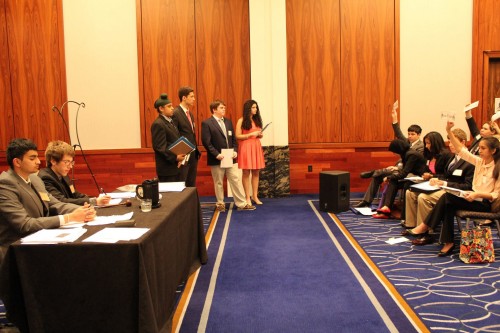
RMC 2013 connected committees together in a way that conferences rarely accomplish. The crises were meant to illuminate the challenges with upholding the Constitution in the face of cybersecurity and other digital threats. The Press Corps committee dutifully followed all of the events at the conference and produced a “RMC Gazette” at the end of each committee session to summarize them. Even in committees that did not feature in the overall storylines, students engaged with their topics and took away lessons about Constitutionalism in the Information Age that tied together with the overall conference. On Sunday morning, each committee session debriefed with a “Sunday Activity” in which the Directors challenged the students to hold mini-constitutional conventions and rewrite the Constitution for the Information Age. Some students saw fit to alter the language of the Constitution to explicitly recognize digital privacy, protect Internet free speech and privacy, and expand Congress’ powers to cyberwarfare. Others thought that the Constitution was appropriate as is, and simply needed to be reinterpreted to remain relevant in the Information Age.
Students left RMC with a more thorough understanding of Constitutionalism in the Information Age, and a unique conference experience that I hope they never forget. This year, RMC decided to go bold and do everything we possibly could to enhance the conference experience for students. The unparalleled thematic focus guided the conference’s substantive development, and the students came up with innovative solutions to the nation’s most pressing political problems in committee. The theme was also implemented outside of committee with the opening ceremonies video, a giant Constitution that hung from a hotel wall, posters displaying provisions of the U.S. Constitution in committee rooms, a live Twitter feed, and QR codes that linked to various online polls and websites relating to the conference theme. Part of the conference experience is not just simulating Congress as it is, but also to give students the knowledge and skills they need to make the world a better place. Overall, the conference was a tremendous success and accomplished its goal of educating students. I would like to conclude by thanking Best Delegate for posting this recap. We genuinely appreciate the opportunity to discuss our staff and students’ achievements this weekend, and are very hopeful that RMC and Best Delegate can work together to create the same online community for Model Congress that Best Delegate has done for Model UN.

